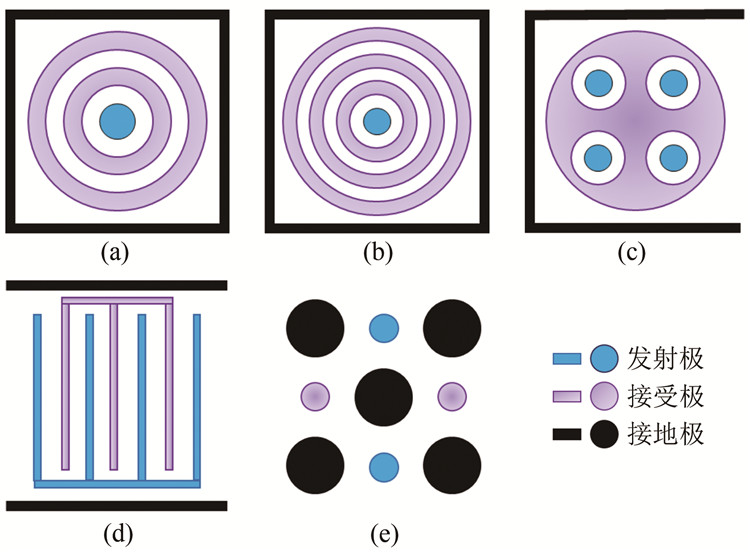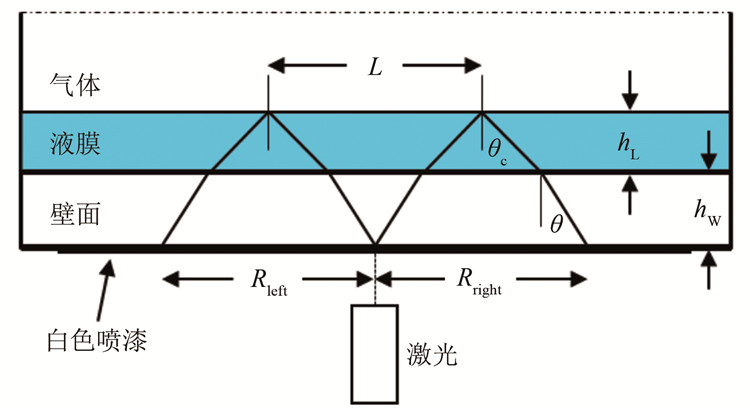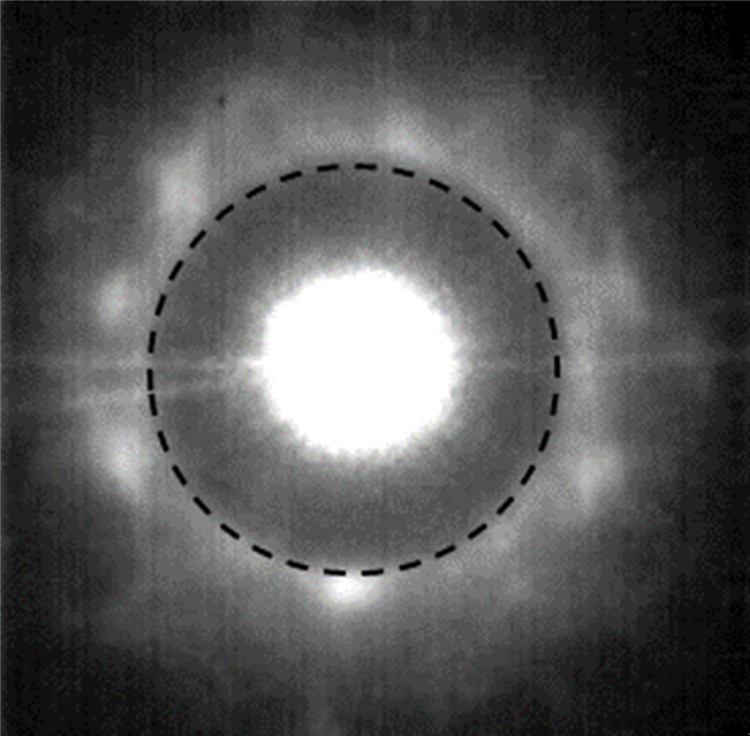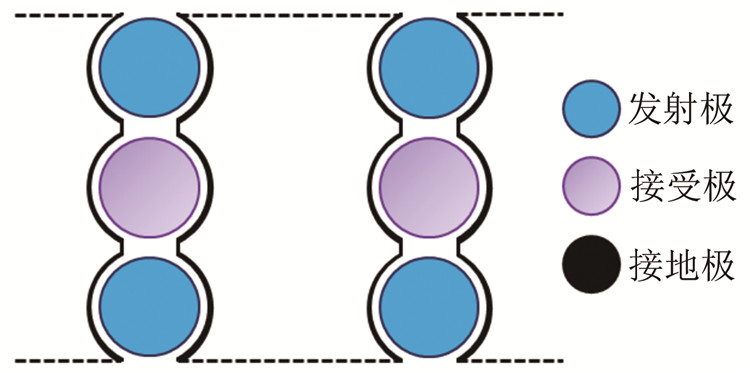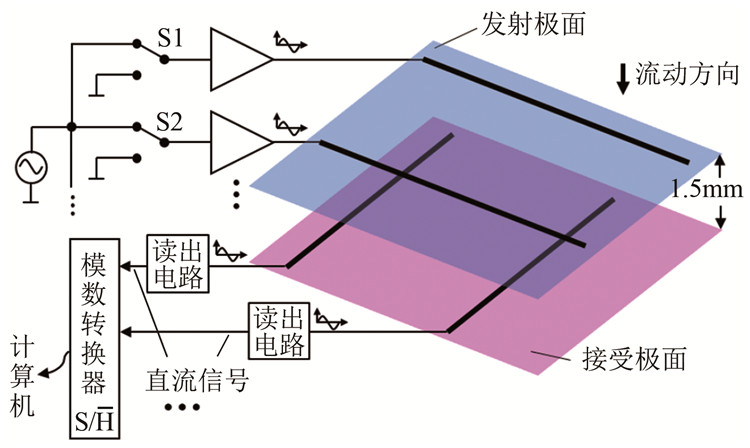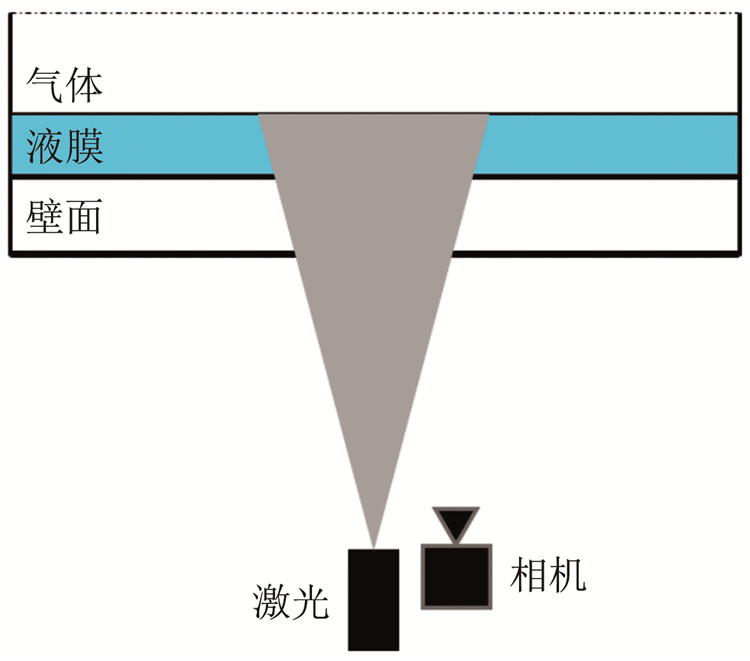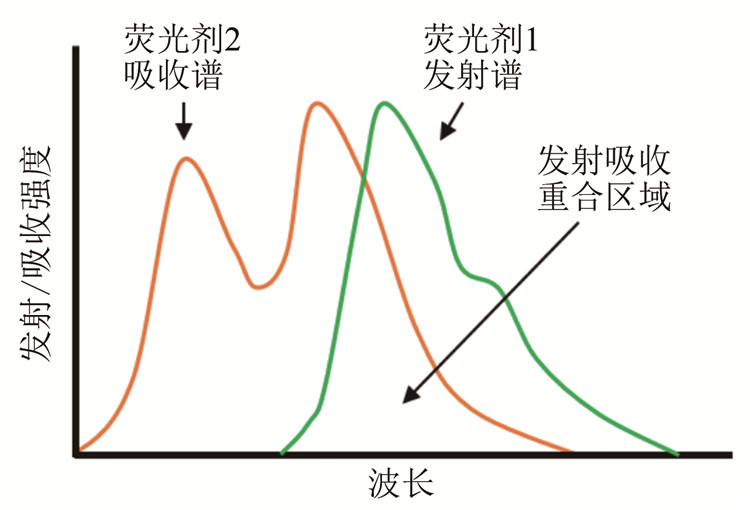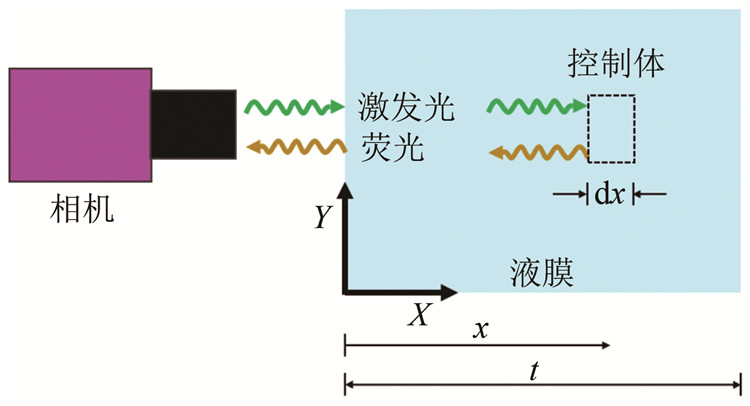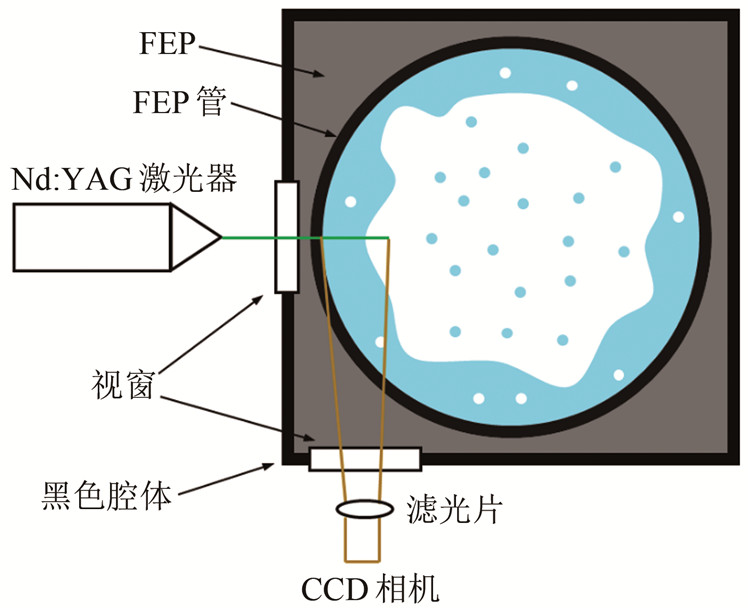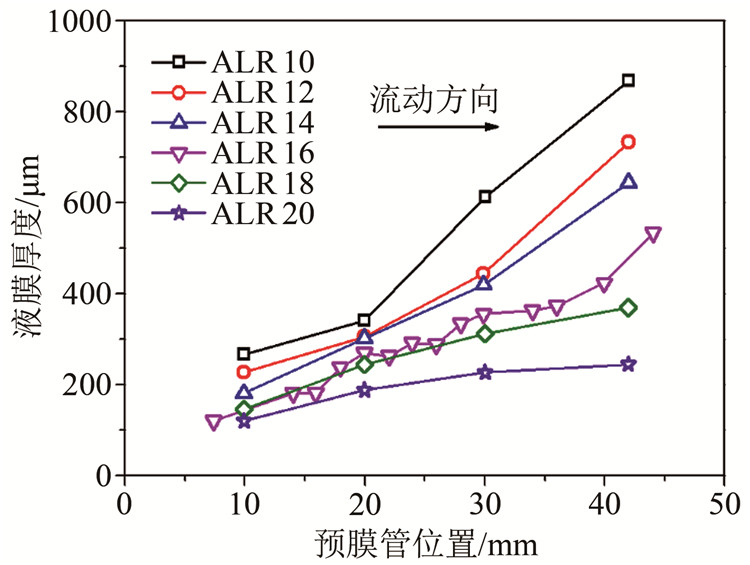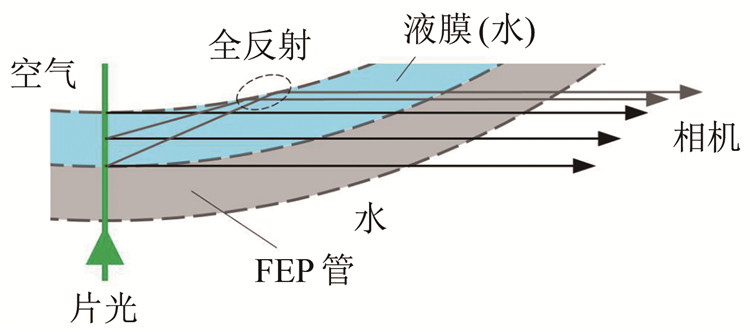A review of the methods of point measurement and spatial measurement on thin liquid film thickness
-
摘要: 液膜现象广泛存在于自然界和工业过程中,特别是在发动机中,燃油雾化通常会形成亚毫米量级乃至微米量级的薄层液膜,其厚度的高精度测量对发动机的设计和改进具有重要意义。介绍了薄层液膜厚度测量中常用的点测量方法和空间测量方法。点测量方法包括电测法和全内反射法,用于单点液膜厚度的测量,具有成本低、操作简单的优点,但不具有空间分辨能力。空间测量方法包括电测法、荧光强度法和平面激光诱导荧光法,可同时测量多个位置乃至连续区间内的液膜厚度,获取液膜分布和运动发展信息。其中电测法操作方便、稳定性高,但是会对液膜产生扰动;而光测法为非侵入方法,适用于高速运动液膜的厚度测量。Abstract: Liquid film phenomena exist widely in nature and in industry processes. In particular, fuel spray in combustion engines can always form the thin liquid film in sub-millimeter or micron scales. The high precision measurement of the liquid film thickness is vital for the design and improvement of combustion engines. In this paper, we briefly review the point measurement and spatial measurement methods that are commonly used in the thin liquid film thickness measurement. Point measurement methods mainly include electric methods and the total internal reflection (TIR) method for measuring the liquid film thickness at a single position, which are low cost and easily operational but have no spatial resolution. Spatial measurement methods mainly include electric methods, fluorescence intensity method and planar laser induced fluorescence (PLIF) method, which can simultaneously measure the liquid film thickness at multiple positions or in continuous regions and obtain the information about the film thickness distribution and film movement and development. Among spatial measurement methods, electric methods are easily operational and highly stable, but the electrodes can disturb the liquid film. On the other hand, the optical methods are always non-intrusive and suitable for the measurement of the liquid film in high speed motion.
-
-
-
[1] GAPALE D L, AROTE S A, PALVE B M, et al. Effect of film thickness on humidity sensing of spray deposited TiO2 thin films[J]. Materials Research Express, 2019, 6: 026402. http://www.wanfangdata.com.cn/details/detail.do?_type=perio&id=IOP_9461001
[2] OBERT P, FUSSER H J, BARTEL D. Oil distribution and oil film thickness within the piston ring-liner contact measured by laser-induced fluorescence in a reciprocating model test under starved lubrication conditions[J]. Tribol Int, 2019, 129: 191-201. DOI: 10.1016/j.triboint.2018.07.022
[3] XUE T, ZHANG S Z, WU B. Study of spatiotemporally resolved temperature field and heat transfer in liquid film using PLIF[J]. Heat Mass Transf, 2019, 55(3): 845-854. DOI: 10.1007/s00231-018-2465-5
[4] DOU P, WU T H, LUO Z P, et al. The application of the principle of wave superposition in ultrasonic measurement of lubricant film thickness[J]. Measurement, 2019, 137: 312-322. DOI: 10.1016/j.measurement.2019.01.057
[5] BONILLA-RIANO A, VELASCO-PENA H F, BANNWART A C, et al. Water film thickness measurement system for oil-water pipe flow[J]. Flow Meas Instrum, 2019, 66: 86-98. DOI: 10.1016/j.flowmeasinst.2019.02.007
[6] 庞昌乐, 赵洪雪, 静大亮, 等.喷油策略对GDI发动机碳烟生成的影响[J].汽车工程, 2017, 39(9): 984-988, 1003. http://d.old.wanfangdata.com.cn/Periodical/qcgc201709002 PANG C L, ZHAO H X, JING D L, et al. Effects of injection strategy on soot formation in GDI engines[J]. Automot Eng, 2017, 39(9): 984-988, 1003. http://d.old.wanfangdata.com.cn/Periodical/qcgc201709002
[7] WANG B Y, MOSBACH S, SCHMUTZHARD S, et al. Modelling soot formation from wall films in a gasoline direct injection engine using a detailed population balance model[J]. Appl Energy, 2016, 163: 154-166. DOI: 10.1016/j.apenergy.2015.11.011
[8] LI X S, PAN H J, DONG X, et al. Spray impingement wall film breakup by wave entrainment[J]. Proc Combust Inst, 2019, 37(3): 3287-3294. DOI: 10.1016/j.proci.2018.07.101
[9] LIU L J, YANG L J. Nonlinear wave evolution of shear-thinning Carreau liquid sheets[J]. J Fluid Mech, 2018, 859: 659-676.
[10] HUGHMARK G A, PRESSBURG B S. Holdup and pressure drop with gas-liquid flow in a vertical pipe[J]. AICHE J, 1961, 7(4): 677-682. DOI: 10.1002/aic.690070429
[11] CRAVAROLO L, HASSID A, VILLANI S. A beta-ray attenuation method for density measurements of liquid-gas mixtures in adiabatic flow[J]. Energ Nucl, 1961, 8(12): 751-757. http://cn.bing.com/academic/profile?id=62fb6b1cd90ddb0554ea06655a9c3f72&encoded=0&v=paper_preview&mkt=zh-cn
[12] CLARK W W. Liquid film thickness measurement[J]. Multiphase Sci Technol, 2002, 14(1): 1-74. http://d.old.wanfangdata.com.cn/Periodical/xasyxyxb201704011
[13] PENA H F V, RODRIGUEZ O M H. Applications of wire-mesh sensors in multiphase flows[J]. Flow Meas Instrum, 2015, 45: 255-273. DOI: 10.1016/j.flowmeasinst.2015.06.024
[14] RIANO A B, BANNWART A C, RODRIGUEZ O M H. Film thickness planar sensor in oil-water flow: prospective study[J]. Sens Rev, 2015, 35(2): 200-209. http://cn.bing.com/academic/profile?id=f949353cef2aa3b9f0b61a527610ed58&encoded=0&v=paper_preview&mkt=zh-cn
[15] RIANO A B, PENA H F V, RODRIGUEZ O M H, et al. High spatial and temporal resolution film thickness planar sensor: comparison of geometries[J]. Sens Rev, 2019, 39(1): 78-86. https://www.researchgate.net/publication/325228715_High_spatial_and_temporal_resolution_film_thickness_planar_sensor_comparison_of_geometries
[16] TIBIRICA C B, DO NASCIMENTO F J, RIBATSKI G. Film thickness measurement techniques applied to micro-scale two-phase flow systems[J]. Exp Therm Fluid Sci, 2010, 34(4): 463-473. DOI: 10.1016/j.expthermflusci.2009.03.009
[17] RUTTINGER S, SPILLE C, HOFFMANN M, et al. Laser-induced fluorescence in multiphase systems[J]. Chem Bio Eng Rev, 2018, 5(4): 253-269. DOI: 10.1002/cben.201800005
[18] GIROUD-GARAPON S, HEID G, LAVERGNE G, et al. A non-invasive liquid film thickness measurement[C]//ASME/JSME 2003 4th Joint Fluids Summer Engineering Conference. Hawaii, USA, 2003.
[19] WANG G R, FIEDLER H E. On high spatial resolution scalar measurement with LIF-Part 2: The noise characteristic[J]. Exp Fluids, 2000, 29(3): 265-274. DOI: 10.1007/s003489900084
[20] ARENDS A A, GERMAIN T M, OWENS J F, et al. Simultaneous reflectometry and interferometry for measuring thin-film thickness and curvature[J]. Rev Sci Instrum, 2018, 89(5): 055117. DOI: 10.1063/1.5021704
[21] HAN Y, SHIKAZONO N, KASAGI N. Measurement of liquid film thickness in a micro parallel channel with interferometer and laser focus displacement meter[J]. Int J Multiph Flow, 2011, 37(1): 36-45. DOI: 10.1016/j.ijmultiphaseflow.2010.08.010
[22] KEELEY A M, WATERS N D, CUMMINS P G, et al. Draining thin films. 2. Laser measurements of film thickness and velocity profile[J]. J Non-Newton Fluid Mech, 1989, 32(1): 79-94. https://www.sciencedirect.com/science/article/abs/pii/0377025789850426
[23] NOZHAT W M. Measurement of liquid-film thickness by laser interferometry[J]. Appl Optics, 1997, 36(30): 7864-7869. DOI: 10.1364/AO.36.007864
[24] ELSÄSSER A, SAMENFINK W, EBNER J, et al. Effect of variable liquid properties on the flow structure within shear-driven wall films[C]//9th International Symposium on Laser Application to Fluid Mechanics, Lisbon, Portugal, 1998.
[25] LILLELEHT L U, HANRATTY T J. Measurement of interfacial structure for co-current air-water flow[J]. J Fluid Mech, 1961, 11(1): 65-81. http://www.wanfangdata.com.cn/details/detail.do?_type=perio&id=S002211206100086X
[26] YU S C M, TSO C P. Simulation of fiber optic sensors in determination of thin liquid film thicknesses[J]. Adv Eng Softw, 1995, 22(1): 55-62. DOI: 10.1016/0965-9978(95)00007-J
[27] ADDLESEE A J, CORNWELL K. Liquid film thickness above a bubble rising under an inclined plate[J]. Chem Eng Res Des, 1997, 75(A7): 663-667. http://www.wanfangdata.com.cn/details/detail.do?_type=perio&id=5d593760738603db041a10fe1db69014
[28] NG T W, NARAIN A, KIVISALU M T. Fluorescence and fiber-optics based real-time thickness sensor for dynamic liquid films[J]. J Heat Transf-Trans ASME, 2010, 132(3): 031603. DOI: 10.1115/1.4000045
[29] PERRON A, KISS L I, VERREAULT R. A multifibre optic sensor to measure the liquid film thickness between a moving bubble and an inclined solid surface[J]. Meas Sci Technol, 2006, 17(6): 1594-1600. DOI: 10.1088/0957-0233/17/6/042
[30] ALEKSEENKO S V, NAKORYAKOV V E, POKUSAEV B G. Wave formation on vertical falling liquid films[J]. Int J Multiph Flow, 1985, 11(5): 607-627. DOI: 10.1016/0301-9322(85)90082-5
[31] BELKIN H H, MACLEOD A A, MONRAD C C, et al. Turbulent liquid flow down vertical walls[J]. AICHE J, 1959, 5(2): 245-248. DOI: 10.1002/aic.690050222
[32] NAKORYAKOV V E, POKUSAEV B G, ALEKSEENKO S V. Stationary two-dimensional rolling waves on a vertical film of fluid[J]. J Eng Phys, 1976, 30(5): 517-521. DOI: 10.1007/BF00863656
[33] SALAZAR R P, MARSCHALL E. Time-average local thickness measurement in falling liquid film flow[J]. Int J Multiph Flow, 1978, 4(4): 405-412. DOI: 10.1016/0301-9322(78)90034-4
[34] SALAZAR R P, MARSCHALL E. Thickness measurement in liquid film flow by laser scattering[J]. Rev Sci Instrum, 1975, 46(11): 1539-1541. DOI: 10.1063/1.1134099
[35] DUKLER A. Characteristics of flow in falling liquid film[J]. Chem Eng Prog, 1952, 48(11): 557-563.
[36] THIELE S, DA SILVA M J, HAMPEL U. Capacitance planar array sensor for fast multiphase flow imaging[J]. IEEE Sens J, 2009, 9(5-6): 533-540. http://www.wanfangdata.com.cn/details/detail.do?_type=perio&id=b8589dbb63c15b002fce04bedcf48413
[37] NOLEN C, POERNER M. Measuring water film thickness in a wet gas compressor diffuser-design, calibration, and testing of electromagnetic probes[J]. J Eng Gas Turbines Power-Trans ASME, 2018, 140(5): 051601. DOI: 10.1115/1.4038151
[38] KIM S, YOON J, YOON Y. Experimental study on the internal flow characteristics for recess length in a swirl coaxialinjector[R]. AIAA 2010-6812, 2010.
[39] PAOLINELLI L D, YAO J, RASHEDI A. Phase wetting detection and water layer thickness characterization in two-phase oil-water flow using high frequency impedance measurements[J]. J Petrol Sci Eng, 2017, 157: 671-679. DOI: 10.1016/j.petrol.2017.07.065
[40] LI X B B, LARSON S D, ZYUZIN A S, et al. Design principles for multicuhannel fringing electric field sensors[J]. IEEE Sens J, 2006, 6(2): 434-440. DOI: 10.1109/JSEN.2006.870161
[41] RIANO A B, BANNWART A C, RODRIGUEZ O M H, et al. A high spatial and temporal resolution film thickness sensor in oil-water flows[C]//2014 IEEE International Instrumentation and Measurement Technology Conference (12 MTC) Procee-dings. 2014.
[42] DAMSOHN M, PRASSER H M. Droplet deposition measurement with high-speed camera and novel high-speed liquid film sensor with high spatial resolution[J]. Nucl Eng Des, 2011, 241(7): 2494-2499. DOI: 10.1016/j.nucengdes.2011.04.016
[43] DAMSOHN M, PRASSER H M. High-speed liquid film sensor for two-phase flows with high spatial resolution based on electrical conductance[J]. Flow Meas Instrum, 2009, 20(1): 1-14. http://www.wanfangdata.com.cn/details/detail.do?_type=perio&id=31075b8f64e2b41238f3d24f0efb2188
[44] CONEY M W E. The theory and application of conductance probes for the measurement of liquid film thickness in two-phase flow[J]. J Phys E Sci Instrum, 1973, 6(9): 903-911. DOI: 10.1088/0022-3735/6/9/030
[45] KOSKIE J E, MUDAWAR I, TIEDERMAN W G. Parallel-wire probes for measurement of thick liquid films[J]. Int J Multiph Flow, 1989, 15(4): 521-530. DOI: 10.1016/0301-9322(89)90051-7
[46] BROWN R C, ANDREUSSI P, ZANELLI S. The use of wire probes for the measurement of liquid film thickness in annular gas-liquid flows[J]. Can J Chem Eng, 1978, 56(6): 754-757. DOI: 10.1002/cjce.5450560618
[47] WANG C, ZHAO N, CHEN C, et al. A method for direct thickness measurement of wavy liquid film in gas-liquid two-phase annular flow using conductance probes[J]. Flow Meas Instrum, 2018, 62: 66-75. DOI: 10.1016/j.flowmeasinst.2018.05.002
[48] MURAV'EV M Y, VASHAK F, KULOV N N. Determination of the instantaneous thickness of a falling liquid film with a microelectrode[J]. Theor Found Chem Eng, 1983, 17(6): 511-515.
[49] FUKANO T. Measurement of time varying thickness of liquid film flowing with high speed gas flow by a constant electric current method (CECM)[J]. Nucl Eng Des, 1998, 184(2-3): 363-377. DOI: 10.1016/S0029-5493(98)00209-X
[50] ALMABROK A A, ALIYU A M, LAO L Y, et al. Gas/liquid flow behaviours in a downward section of large diameter vertical serpentine pipes[J]. Int J Multiph Flow, 2016, 78: 25-43. DOI: 10.1016/j.ijmultiphaseflow.2015.09.012
[51] HURLBURT E T, NEWELL T A. Optical measurement of liquid film thickness and wave velocity in liquid film flows[J]. Exp Fluids, 1996, 21(5): 357-362. DOI: 10.1007/BF00189056
[52] KIURA T, SHEDD T A, BLASER B C. Investigation of spray evaporation and numerical model applied for fuel-injection small engines[J]. SAE Int J Engines, 2008, 1(1): 1402-1409. DOI: 10.4271/2008-32-0064
[53] SHEDD T A, NEWELL T A. Automated optical liquid film thickness measurement method[J]. Rev Sci Instrum, 1998, 69(12): 4205-4213. DOI: 10.1063/1.1149232
[54] KABARDIN I, MELEDIN V, ELISEEV I, et al. Optical measurement of instantaneous liquid film thickness based on total internal reflection[J] J Eng Thermophys, 2011, 20(4): 407-415. DOI: 10.1134/S1810232811040072
[55] KABARDIN I K, NAUMOV I V, DESTECH PUBLICAT I. Reflection method for optical measurements of transparent ice on a wind turbine blade[M]. Lancaster: Destech Publications Inc, 2015.
[56] KABARDIN I K, MELEDIN V G, DVOINISHNIKOV S V, et al. Remote monitoring of ice loading on wind turbine blades based on total internal reflection[J] J Eng Thermophys, 2016, 25(4): 504-508. DOI: 10.1134/S181023281604007X
[57] PARAS S V, KARABELAS A J. Properties of the liquid layer in horizontal annular flow[J]. Int J Multiph Flow, 1991, 17(4): 439-454. DOI: 10.1016/0301-9322(91)90041-Z
[58] PAUTSCH A G, SHEDD T A. Adiabatic and diabatic measurements of the liquid film thickness during spray cooling with FC-72[J]. Int J Heat Mass Tran, 2006, 49(15-16): 2610-2618. DOI: 10.1016/j.ijheatmasstransfer.2006.01.024
[59] SHEDD T A, CORN M L, COHEN J M, et al. Liquid film formation byan impinging jet in a high-velocity air stream[R]. AIAA 2009-998, 2009.
[60] SHEDD T A, NEWELL T A. Characteristics of the liquid film and pressure drop in horizontal, annular, two-phase flow through round, square and triangular tubes[J] J Fluids Eng-Trans ASME, 2004, 126(5): 807-817. DOI: 10.1115/1.1792261
[61] XIAO J G, HRNJAK P. A new flow regime map and void fraction model based on the flow characterization of condensation[J]. Int J Heat Mass Tran, 2017, 108: 443-452. DOI: 10.1016/j.ijheatmasstransfer.2016.11.104
[62] DRAKE M C, FANSLER T D, SOLOMON A S, et al. Piston fuel films as a source of smoke and hydrocarbon emissions from a wall-controlled spark-ignited sirect-injection engine[R]. SAE Technical Paper 2003-2001-0547, 2003.
[63] YANG B, GHANDHI J. Measurement of diesel spray impingement and fuel film characteristics using refractive index matching method[R]. SAE Technical Paper 2007-2001-0485, 2007.
[64] MALIGNE D, BRUNEAUX G. Time-resolved fuel film thickness measurement for direct injection SI engines using refractive index matching[R]. SAE Technical Paper 2011-2001-1215, 2011.
[65] HENKEL S, BEYRAU F, HARDALUPAS Y, et al. Novel method for the measurement of liquid film thickness during fuel spray impingement on surfaces[J]. Opt Express, 2016, 24(3): 2542-2561. DOI: 10.1364/OE.24.002542
[66] LUO H L, UCHITOMI S, NISHIDA K, et al. Experimental investigation on fuel film formation by spray impingement on flat walls with different surface roughness[J]. Atom Sprays, 2017, 27(7): 611-628. DOI: 10.1615/AtomizSpr.2017019706
[67] DING C P, SJOBERG M, VUILLEUMIER D, et al. Fuel film thickness measurements using refractive index matching in a stratified-charge SI engine operated on E30 and alkylate fuels[J]. Exp Fluids, 2018, 59(3): 59. DOI: 10.1007/s00348-018-2512-5
[68] SILVA M J D, SVHNEL T, SCHLEICHER E, et al. Planar array sensor for high-speed component distribution imaging in fluid flow applications[J]. Sensors, 2007, 7(10): 2430-2445. DOI: 10.3390/s7102430
[69] PRASSER H M, BOTTGER A, ZSCHAU J. A new electrode-mesh tomograph for gas-liquid flows[J]. Flow Meas Instrum, 1998, 9(2): 111-119. https://www.sciencedirect.com/science/article/abs/pii/S0955598698000156
[70] DAMSOHN M, PRASSER H M. High-speed liquid film sensor with high spatial resolution[J]. Meas Sci Technol, 2009, 20(11): 114001. DOI: 10.1088/0957-0233/20/11/114001
[71] DAMSOHN M, PRASSER H M. Experimental studies of the effect of functional spacers to annular flow in subchannels of a BWR fuel element[J]. Nucl Eng Des, 2010, 240(10): 3126-3144. DOI: 10.1016/j.nucengdes.2010.05.032
[72] ITO D, DAMSOHN M, PRASSER H M, et al. Dynamic film thickness between bubbles and wall in a narrow channel[J]. Exp Fluids, 2011, 51(3): 821-833. DOI: 10.1007/s00348-011-1105-3
[73] ZBORAY R, KICKHOFEL J, DAMSOHN M, et al. Cold-neutron tomography of annular flow and functional spacer performance in a model of a boiling water reactor fuel rod bundle[J]. Nucl Eng Des, 2011, 241(8): 3201-3215. DOI: 10.1016/j.nucengdes.2011.06.029
[74] HUANG H J, DHIR V K, PAN L M. Liquid film thickness measurement underneath a gas slug with miniaturized sensor matrix in a microchannel[J]. Microfluidics and Nanofluidics, 2017, 21(10): 159. DOI: 10.1007/s10404-017-1998-0
[75] WONG R D P, POSNER J D, SANTOS V J. Flexible microfluidic normal force sensor skin for tactile feedback[J]. Sens Actuator A-Phys, 2012, 179: 62-69. DOI: 10.1016/j.sna.2012.03.023
[76] HE D H, CHEN S L, BAI B F. Void fraction measurement of stratified gas-liquid flow based on multi-wire capacitance probe[J]. Exp Therm Fluid Sci, 2019, 102: 61-73. DOI: 10.1016/j.expthermflusci.2018.11.005
[77] OFUCHI C Y, EIDT H K, RODRIGUES C C, et al. Multiple wire-mesh sensors applied to the characterization of two-phase flow inside a cyclonic flow distribution system[J]. Sensors, 2019, 19(1): 193. DOI: 10.3390/s19010193
[78] CELY M M H, BAPTISTELLA V E C, RODRIGUEZ O M H. Study and characterization of gas-liquid slug flow in an annular duct, using high speed video camera, wire-mesh sensor and PIV[J]. Exp Therm Fluid Sci, 2018, 98: 563-575. DOI: 10.1016/j.expthermflusci.2018.06.031
[79] SEKOGUCHI K, TAKEISHI M, ISHIMATSU T. Interfacial structure in vertical upward annular flow[J]. PhysicoChem Hydrodyn, 1985, 6(1-2): 239-255.
[80] TAKEISHI M, SEKOGUCHI K, SHIMIZU H, et al. Velocity of liquid lumps in vertical upward gas-liquid two-phase flow[J]. Nihon Kikai Gakkai Ronbunshu B, 1987, 53(493): 2800-2806. http://cn.bing.com/academic/profile?id=82ba802523a9964004ebfd830b8dece1&encoded=0&v=paper_preview&mkt=zh-cn
[81] SEKOGUCHI K, TAKEISHI M. Interfacial structures in upward huge wave flow and annular flow regimes[J]. Int J Multiph Flow, 1989, 15(3): 295-305. DOI: 10.1016/0301-9322(89)90002-5
[82] DA SILVA M J, SCHLEICHER E, HAMPEL U. Capacitance wire-mesh sensor for fast measurement of phase fraction distributions[J]. Meas Sci Technol, 2007, 18(7): 2245-2251. DOI: 10.1088/0957-0233/18/7/059
[83] DA SILVA M J, HAMPEL U. A field-focusing imaging sensor for fast visualization of multiphase flows[J]. Meas Sci Technol, 2009, 20(10): 104009. DOI: 10.1088/0957-0233/20/10/104009
[84] LOPEZ J M, MOHAN R, SHOHAM O, et al. Experimental investigation of falling liquid film in vertical download two-phase pipe flow[C]//Proceedings of the ASME Fluids Engineering Division Summer Meeting. 2012.
[85] VIEIRA R E, PARSI M, MCLAURY B S, et al. Experimental characterization of vertical downward two-phase annular flows using wire-mesh sensor[J]. Chem Eng Sci, 2015, 134: 324-339. DOI: 10.1016/j.ces.2015.05.013
[86] CUI Z Q, WANG H X, CHEN Z Q, et al. Image reconstruction for field-focusing capacitance imaging[J]. Meas Sci Technol, 2011, 22(3): 035501. DOI: 10.1088/0957-0233/22/3/035501
[87] IDER Y Z, EYUBOGLU B M, KUZUOGLU M, et al. A method for comparative evaluation of EIT algorithms using a standard data set[J]. Physiological Mensurement, 1995, 16(supplement 3A): A227-A236. http://cn.bing.com/academic/profile?id=23c4841164b65fdc6805015b263951fc&encoded=0&v=paper_preview&mkt=zh-cn
[88] STEINER G, WATZENIG D, ZANGL H, et al. Impact of the reconstruction method on the point spread function in electrical tomography[C]//13th International Conference on Electrical Bioimpedance and the 8th Conference on Electrical Impedance Tomography, New York, 2007.
[89] KARASSO P S, MUNGAL M G. PLIF measurements in aqueous flows using the Nd: YAG laser[J]. Exp Fluids, 1997, 23(5): 382-387. DOI: 10.1007/s003480050125
[90] GRESZIK D, YANG H N, DREIER T, et al. Laser-based diagnostics for the measurement of liquid water film thickness[J]. Appl Optics, 2011, 50(4): A60-A67. http://www.wanfangdata.com.cn/details/detail.do?_type=perio&id=f600e6b947ebeb507c67ceb9ab2b41eb
[91] CHERDANTSEV A V, HANN D B, AZZOPARDI B J. Study of gas-sheared liquid film in horizontal rectangular duct using high-speed LIF technique: Three-dimensional wavy structure and its relation to liquid entrainment[J]. Int J Multiph Flow, 2014, 67: 52-64. DOI: 10.1016/j.ijmultiphaseflow.2014.08.003
[92] MORTON C E, BAKER R C, HUTCHINGS I M. Measurement of liquid film thickness by optical fluorescence and its application to an oscillating piston positive displacement flowmeter[J]. Meas Sci Technol, 2011, 22(12): 125403. DOI: 10.1088/0957-0233/22/12/125403
[93] SCHULZ F, SCHMIDT J, BEYRAU F. Development of a sensitive experimental set-up for LIF fuel wall film measurements in a pressure vessel[J]. Exp Fluids, 2015, 56(5): 98. DOI: 10.1007/s00348-015-1971-1
[94] SCHULZ F, BEYRAU F. The effect of operating parameters on the formation of fuel wall films as a basis for the reduction of engine particulate emissions[J]. Fuel, 2019, 238: 375-384. DOI: 10.1016/j.fuel.2018.10.109
[95] HOANG A, BERTELOOT G, SHARIF-KASHANI P, et al. Dynamic measurement of microfilms and nanofilms of fluids using fluorescence microscopy[J]. Exp Fluids, 2012, 52(6): 1657-1662. DOI: 10.1007/s00348-012-1279-3
[96] COPPETA J, ROGERS C. Dual emission laser induced fluorescence for direct planar scalar behavior measurements[J]. Exp Fluids, 1998, 25(1): 1-15. DOI: 10.1007/s003480050202
[97] HIDROVO C H, HART D P. Emission reabsorption laser induced fluorescence (ERLIF) film thickness measurement[J]. Meas Sci Technol, 2001, 12(4): 467-477. DOI: 10.1088/0957-0233/12/4/310
[98] HIDROVO C H, BRAU R R, HART D P. Excitation nonlinearities in emission reabsorption laser-induced fluorescence techniques[J]. Appl Optics, 2004, 43(4): 894-913. DOI: 10.1364/AO.43.000894
[99] SCHUBRING D, ASHWOOD A C, SHEDD T A, et al. Planar laser-induced fluorescence (PLIF) measurements of liquid film thickness in annular flow. Part I: Methods and data[J]. Int J Multiph Flow, 2010, 36(10): 815-824. DOI: 10.1016/j.ijmultiphaseflow.2010.05.007
[100] SCHUBRING D, SHEDD T A, HURLBURT E T. Planar laser-induced fluorescence (PLIF) measurements of liquid film thickness in annular flow. Part II: Analysis and comparison to models[J]. Int J Multiph Flow, 2010, 36(10): 825-835. DOI: 10.1016/j.ijmultiphaseflow.2010.02.002
[101] ALEKSEENKO S V, ANTIPIN V A, CHERDANTSEV A V, et al. Investigation of waves interaction in annular gas-liquid flow using high-speed fluorescent visualization technique[J]. Microgravity Sci Technol, 2008, 20(3-4): 271-275. DOI: 10.1007/s12217-008-9028-1
[102] ALEKSEENKO S, CHERDANTSEV A, CHERDANTSEV M, et al. Application of a high-speed laser-induced fluorescence technique for studying the three-dimensional structure of annular gas-liquid flow[J]. Exp Fluids, 2012, 53(1): 77-89. DOI: 10.1007/s00348-011-1200-5
[103] FARIAS P S C, MARTINS F, SAMPAIO L E B, et al. Liquid film characterization in horizontal, annular, two-phase, gas-liquid flow using time-resolved laser-induced fluorescence[J]. Exp Fluids, 2012, 52(3): 633-645. DOI: 10.1007/s00348-011-1084-4
[104] VOLZ M, KONLE M, GEBRETSADIK M, et al. Investigation of a Prefilming Airblast Atomizer With Respect to Surface Stripping[C]//Proceedings of ASME Turbo Expo 2015: Turbine Technical Conference and Exposition. 2015.
[105] SHANMUGADAS K P, CHAKRAVARTHY S R. A canonical geometry to study wall filming and atomization in pre-filming coaxial swirl injectors[J]. Proc Combust Inst, 2017, 36(2): 2467-2474. DOI: 10.1016/j.proci.2016.08.082
[106] HABER T, GEBRETSADIK M, BOCKHORN H, et al. The effect of total reflection in PLIF imaging of annular thin films[J]. Int J Multiph Flow, 2015, 76: 64-72. DOI: 10.1016/j.ijmultiphaseflow.2015.06.009
[107] CHAROGIANNIS A, AN J S, MARKIDES C N. A simultaneous planar laser-induced fluorescence, particle image velocimetry and particle tracking velocimetry technique for the investigation of thin liquid-film flows[J]. Exp Therm Fluid Sci, 2015, 68: 516-536. DOI: 10.1016/j.expthermflusci.2015.06.008







 下载:
下载:
